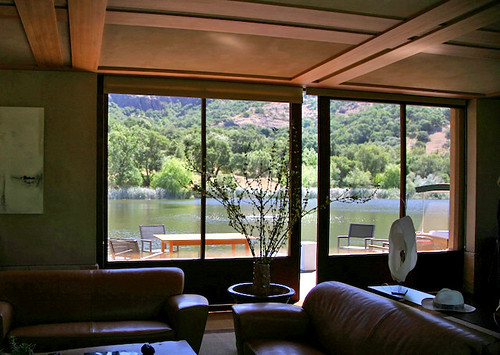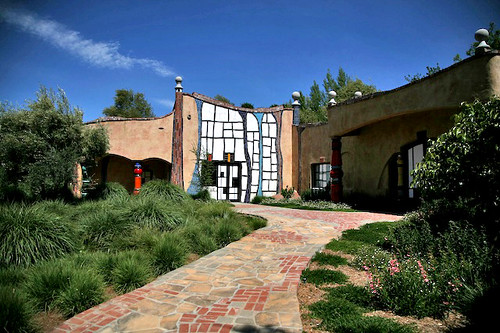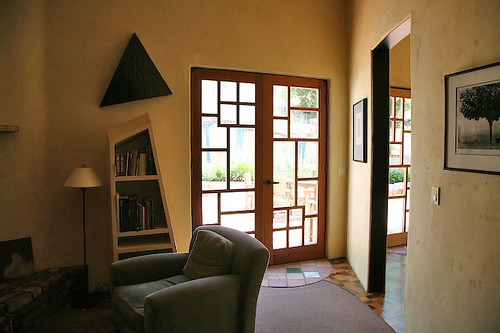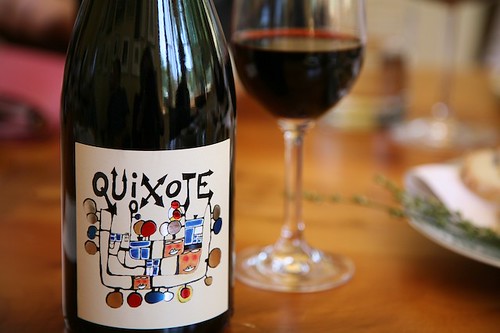See more photos in the Flickr photoset
Tucked away at the end of a long private road at the base of the jagged edges of Stags’ Leap cliffs in Napa Valley is the first, last, and only building in North America designed by Austrian artist Frederick Hundertwasser, the Quixote Winery. As a participant of the Taste3 conference, I recently had the privilege of touring this architectural delight. Here are a few highlights.
Hundertwasser was a singularly unusual man. An environmentalist, a nudist (he gave a press conference in the nude on at least one occasion), a ladies man (he died in his 70s on the QE2 on route back from Asia with his 20-something Japanese girlfriend), Hundertwasser was a wildly distinctive artist (think of mash-up of Klimt and Gaudi), whose works spanned from prints to public housing to postage stamps.
Little wonder that when Carl Doumani, founder of Stags’ Leap Winery, happened upon a Hundertwasser art calendar in an architect’s office he knew he had found the inspiration for the building of his new winery, a winery named after one of the most imaginative characters in the history of literature. Yet it took years just to get an introduction to Hundertwasser. According to Carl, when that introduction finally took place and Hundertwasser agreed to see him, Carl flew all the way to Vienna for the meeting just to have Hundertwasser ditch their arranged dinner that night in favor of some sweet young thing. Eventually Carl did get his meeting, and did convince the artist to come visit the site of the winery.
Carl and Pamela’s home is right on the winery lake at the base of the Stags’ Leap Cliffs. According to Pam, soon after Hundertwasser arrived at their home, he stripped off his clothes, dove in the lake, swam across it and back, got out and announced that he would do the job.
It then took another 10 years to design and build the winery. Hundertwasser never did see the completed building. He died shortly before it was finished. But he made several trips to Quixote Winery during the building, refining the design during construction.
The winery is somewhat obscured by trees from the parking area. As you walk up the brick and stone pathway that seems to flow down from the winery like a meandering creek, the building reveals itself, resplendent with colorful tile, uneven lines, and Hundertwasser’s signature golden onion dome.
Hundertwasser didn’t believe in straight lines, or right angles, or even flat surfaces. He wanted the experience of being in his buildings to mimic nature a little bit. When one walks on a trail in the woods, one expects the trail to slope up or down and turn this way and that. Lines curve and flow in nature, and so they do in a Hundertwasser design. He also believed that trees had a place too, a right even, to be housed in the buildings of humans. So Hundertwasser buildings typically have trees and bushes growing on their roofs. If you look at the photo of Quixote’s onion dome you’ll see a young olive tree, and several others popping up into view along the edge of the roof.
The interior of Quixote winery displays just as much whimsy as the exterior. Hundertwasser didn’t believe in matching windows, nor in perfect symmetry.
Of course every bottle of wine must have a label. Hundertwasser designed this one for Carl:
Carl told our group that he wanted to look out of his office and see people smiling as they approached the winery. I think he got his wish.
Quixote Winery has recently opened to the public for private tours by appointment only. For tour information, you can check the Quixote Winery website. (More photos)








Elise, this brings back memories of a wonderful afternoon! Thanks for posting about it… you’ve remembered a few details that I had forgotten about.